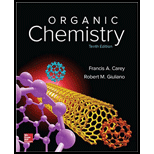
ORGANIC CHEMISTRY (LL)-W/SOLN.>CUSTOM<
10th Edition
ISBN: 9781259972348
Author: Carey
Publisher: MCG CUSTOM
expand_more
expand_more
format_list_bulleted
Concept explainers
Question
Chapter 5.13, Problem 16P
Interpretation Introduction
Interpretation:
The potential energy diagram for the reaction of
Concept introduction:
The reaction between
The poor leaving group
Expert Solution & Answer
Want to see the full answer?
Check out a sample textbook solution
Students have asked these similar questions
What is the product of the reaction?
F3C.
CF3
OMe
NaOH / H₂O
What is the product of the reaction?
F3C.
CF3
OMe
NaOH / H₂O
What would you expect to be the major product obtained from the following reaction? Please explain what is happening here. Provide a detailed explanation and a drawing showing how the reaction occurs. The correct answer to this question is V.
Chapter 5 Solutions
ORGANIC CHEMISTRY (LL)-W/SOLN.>CUSTOM<
Ch. 5.1 - Prob. 1PCh. 5.1 - Prob. 2PCh. 5.1 - Many compounds contain more than one functional...Ch. 5.2 - Prob. 4PCh. 5.3 - Prob. 5PCh. 5.4 - Classify the isomeric C4H10O alcohols as being...Ch. 5.5 - Bromine is less electronegative than chlorine, yet...Ch. 5.6 - Prob. 8PCh. 5.7 - Prob. 9PCh. 5.8 - Prob. 10P
Ch. 5.8 - Prob. 11PCh. 5.9 - Carbocations are key intermediates in petroleum...Ch. 5.9 - Prob. 13PCh. 5.9 - Prob. 14PCh. 5.11 - Prob. 15PCh. 5.13 - Prob. 16PCh. 5.14 - For the reaction of a primary alcohol RCH2OH with...Ch. 5.15 - Prob. 18PCh. 5 - Write structural formulas for each of the...Ch. 5 - Prob. 20PCh. 5 - Prob. 21PCh. 5 - Write structural formulas for all the...Ch. 5 - Prob. 23PCh. 5 - Prob. 24PCh. 5 - Epichlorohydrin is the common name of an...Ch. 5 - Prob. 26PCh. 5 - Prob. 27PCh. 5 - Prob. 28PCh. 5 - Some of the most important organic compounds in...Ch. 5 - Prob. 30PCh. 5 - Prob. 31PCh. 5 - Prob. 32PCh. 5 - Prob. 33PCh. 5 - Prob. 34PCh. 5 - Prob. 35PCh. 5 - Prob. 36PCh. 5 - Prob. 37PCh. 5 - Prob. 38PCh. 5 - Prob. 39PCh. 5 - Prob. 40PCh. 5 - The reaction of 2,2-dimethyl-1-propanol...Ch. 5 - (a) Assuming that the rate-determining elementary...Ch. 5 - The reaction of 3-tert-butyl-3-pentanol with...Ch. 5 - Prob. 44PCh. 5 - Prob. 45PCh. 5 - Prob. 46DSPCh. 5 - Prob. 47DSPCh. 5 - Prob. 48DSPCh. 5 - Prob. 49DSPCh. 5 - Prob. 50DSPCh. 5 - Prob. 51DSPCh. 5 - Prob. 52DSP
Knowledge Booster
Learn more about
Need a deep-dive on the concept behind this application? Look no further. Learn more about this topic, chemistry and related others by exploring similar questions and additional content below.Similar questions
- Please answer the question for the reactions, thank youarrow_forwardWhat is the product of the following reaction? Please include a detailed explanation of what is happening in this question. Include a drawing showing how the reagent is reacting with the catalyst to produce the correct product. The correct answer is IV.arrow_forwardPlease complete the reactions, thank youarrow_forward
- Consider the synthesis. What is compound Y? Please explain what is happening in this question. Provide a detailed explanation and a drawing to show how the compound Y creates the product. The correct answer is D.arrow_forwardWhat would be the major product of the following reaction? Please include a detailed explanation of what is happening in this question. Include steps and a drawing to show this reaction proceeds and how the final product is formed. The correct answer is B. I put answer D and I don't really understand what is going on in the question.arrow_forwardWhat is the product of the following reaction? Please explain what is happening in this question. Provide a detailed explanation and a drawing showing how the reagent is reacting with the catalysts to product the correct product. The correct answer is B.arrow_forward
- What is the missing intermediate 1 and the final product 2. Please include a detailed explanation explaining the steps of malonic ester synthesis. Please include drawings of the intermediate and how it occurs and how the final product is former.arrow_forwardWhat would be the reagents and conditions above and below the arrow that will complete the proposed acetoacetic ester synthesis? If it cannot be done efficiently, then I will choose that answer. There could be 2 or 4 reagents involved. Please provide a detailed explanation and drawings showing how it would proceed with the correct reagents.arrow_forwardFor benzene, the ∆H° of vaporization is 30.72 kJ/mol and the ∆S° of vaporization is 86.97 J/mol・K. At 1.00 atm and 228.0 K, what is the ∆G° of vaporization for benzene, in kJ/mol?arrow_forward
- The reaction Q(g) + R(g) → Z(l) is shown to be exothermic. Which of the following is true concerning the reaction. it is spontaneous only at High T, it is spontaneous at low T it is nonspontaneous at all T it is spontanrous at all T. it is non spontaneous only at low T.arrow_forwardThe reaction Q(g) + R(g) → Z(l) is shown to be exothermic. Which of the following is true concerning the reactionarrow_forwardWhich of the following has the largest standard molar entropy, S° (298.15 K) He H2 NaCl KBr Hgarrow_forward
arrow_back_ios
SEE MORE QUESTIONS
arrow_forward_ios
Recommended textbooks for you
 Macroscale and Microscale Organic ExperimentsChemistryISBN:9781305577190Author:Kenneth L. Williamson, Katherine M. MastersPublisher:Brooks Cole
Macroscale and Microscale Organic ExperimentsChemistryISBN:9781305577190Author:Kenneth L. Williamson, Katherine M. MastersPublisher:Brooks Cole Organic ChemistryChemistryISBN:9781305580350Author:William H. Brown, Brent L. Iverson, Eric Anslyn, Christopher S. FootePublisher:Cengage Learning
Organic ChemistryChemistryISBN:9781305580350Author:William H. Brown, Brent L. Iverson, Eric Anslyn, Christopher S. FootePublisher:Cengage Learning

Macroscale and Microscale Organic Experiments
Chemistry
ISBN:9781305577190
Author:Kenneth L. Williamson, Katherine M. Masters
Publisher:Brooks Cole

Organic Chemistry
Chemistry
ISBN:9781305580350
Author:William H. Brown, Brent L. Iverson, Eric Anslyn, Christopher S. Foote
Publisher:Cengage Learning

Alcohols, Ethers, and Epoxides: Crash Course Organic Chemistry #24; Author: Crash Course;https://www.youtube.com/watch?v=j04zMFwDeDU;License: Standard YouTube License, CC-BY